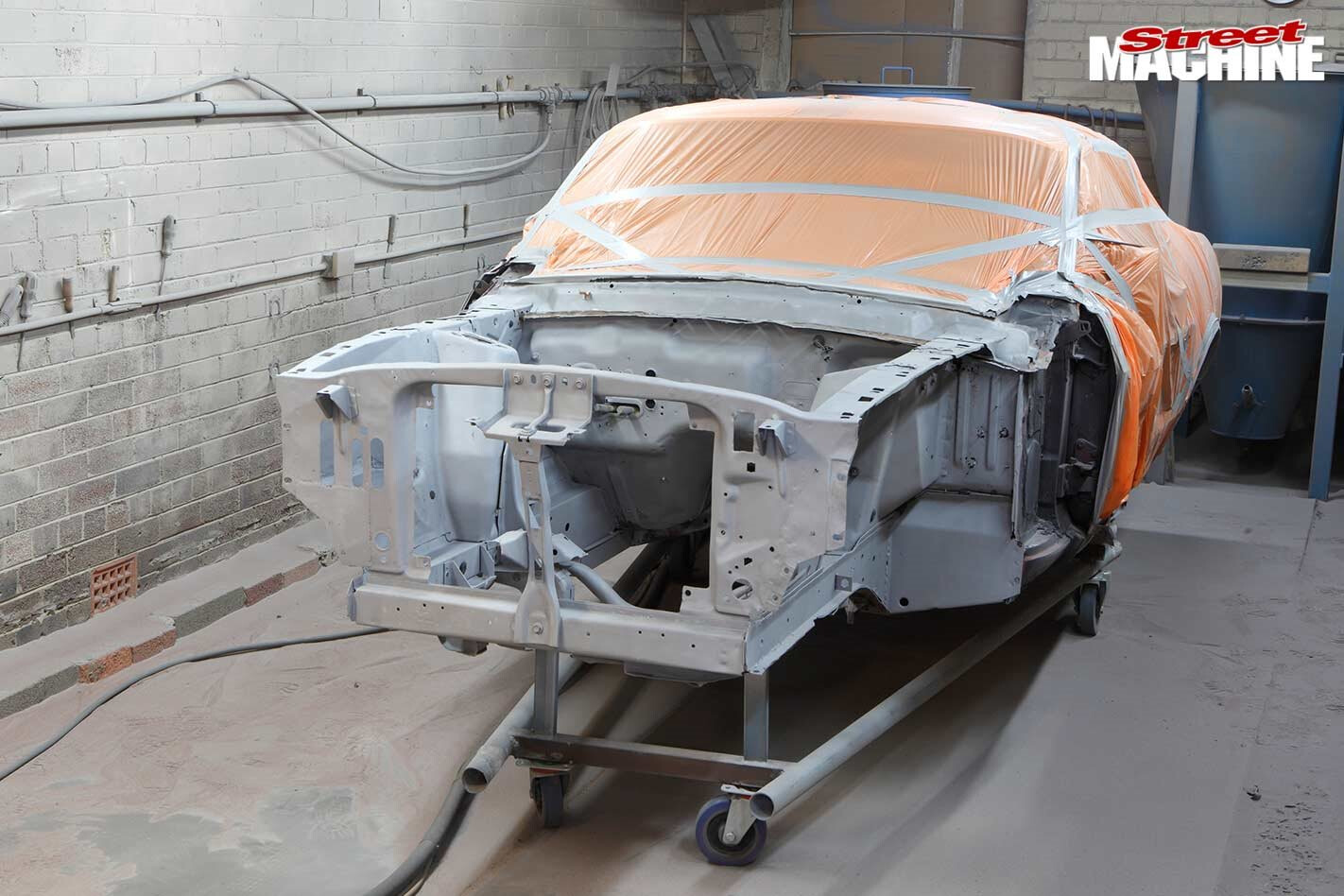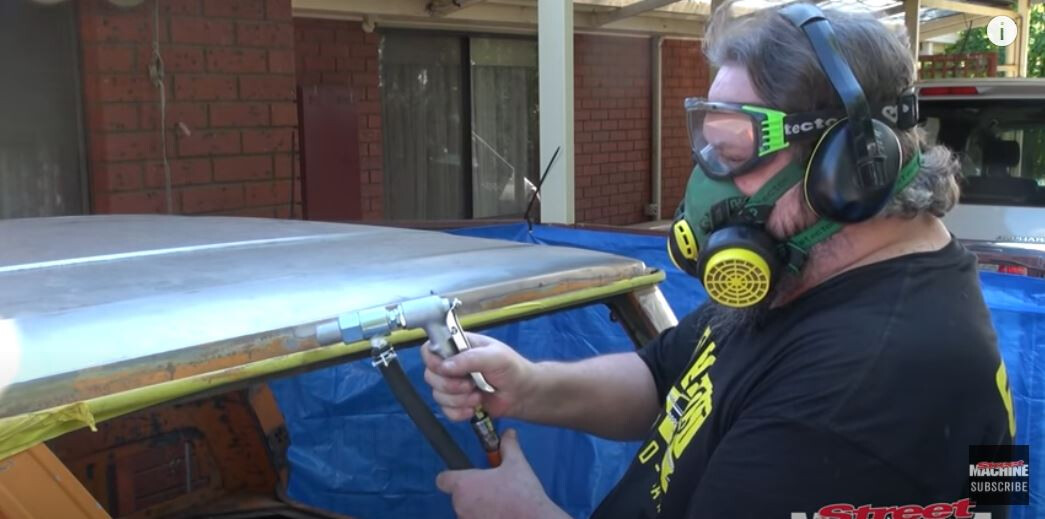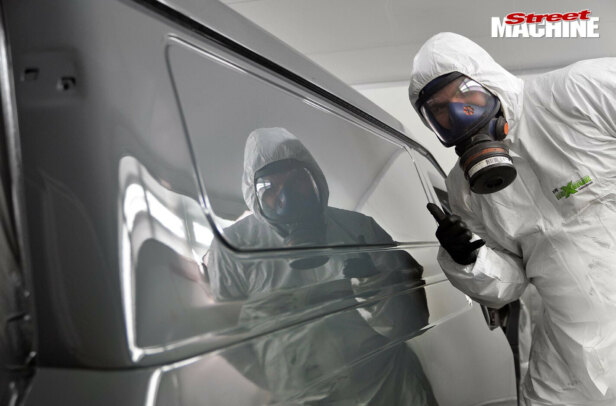UNLESS you know exactly what’s under your paint, the only way to be 100 per cent sure that any fresh coats will stand the test of time is to strip the car back to bare metal. If you don’t, any underlying issues will eventually rear their ugly head — often bigger and badder than the original blemish.
This article was first published in the September 2012 issue of Street Machine
There are a number of ways to strip old paint. The most common methods include chemical (paint stripper, dipping), mechanical (sanding) and abrasive (blasting).
The latter can be divided into sandblasting, soda blasting and media blasting. Sand is way too aggressive, while soda blasting, like paint stripper, won’t deal with heavy corrosion. Which just leaves media blasting.
Sydney-based Quik Strip specialises in marine and automotive media blasting. The owner, Scott Morris, looks after the marine side of the business, while Greg Morris (seen here) looks after the general and automotive work.
With its ability to bite into corrosion, proof coat and filler, media blasting is ideal for stripping away the years of use and abuse street machines typically rack up.
That said, it is very powerful and the operator need to be diligent to avoid blasting away the top surface of the metal. Quik Strip has seen an example where a bolt was left in place and the metal around it was eroded to the extent that when the bolt was removed, it looked like there was a washer sitting where the bolt had been.
We dropped into Quik Strip’s Bankstown premises for all the ins and outs of this effective paint-removal process.
STEP 1. Bought sight unseen from the US, this ’67 Fastback Mustang was pretty sweet on the outside, with a good interior too. However the engine bay and undercarriage were basket cases. Poorly repaired collision damage was evident, along with a multitude of random holes and signs of corrosion. The plan of attack was to strip the suspect areas back to bare metal, repair all the blemishes and add fresh paint.
STEP 2. These two patches on top of the inner fender rails are the most obvious signs of corrosion. It’s imperative to get deeply pitted and aggressive corrosion like this thoroughly clean, otherwise when it breaks out again later on, it will come back twice as bad. The other tell-tale sign that all was not well was the liberal application of non-factory proof coat to the interior engine bay panels and radiator support.
STEP 3. As you’ll note in Step 09, media blasting creates enormous amounts of very fine dust, which works its way into every nook and cranny. To ensure the Mustang’s interior didn’t end up chock-full of blasting material, all holes, openings and orifices in the firewall, scuttle and floor were blocked off or covered up. Cardboard is more resilient than tape, plastic or paper, so it’s the material of choice.
STEP 4. Seeing as the exterior paint was in pristine condition, extra precautions were taken to protect it during the blasting process. Greg (white T-shirt) taped up all the vulnerable edges before masking off the rest of the exterior. On these edges, the tape was wrapped well over and firmly pressed down to ensure the high-velocity media didn’t get in under the tape and begin removing paint in unwanted areas.
STEP 5. Using paper to mask the car is a waste of time. “It might as well not be there,” Greg says. “It blows straight off as soon as you go anywhere near it.” Cheap plastic drop sheets (as found at your local hardware store) work a treat. While not able to withstand a direct blast, they let you get close without tearing. Also, the generous size minimises the number of leak-prone joins.
STEP 6. Note the use of plastic tape as opposed to masking tape. Masking tape comes off at the very first blast. While not impervious to blasting, the plastic tape Quik Strip uses has a bit more give; you can wander onto it two to three times before it starts to peel away. It also peels gradually, which gives the operator a bit of warning, and it remains more visible in the dusty booth.
STEP 7. The plastic covering needs to be thoroughly taped down to stop it tearing if air gets underneath, as well as to prevent it from flapping as that would act like sandpaper on the painted surfaces. Even with all this effort, a small amount of dust will still work its way inside; it’s impossible to get it 100 per cent airtight. Once the Mustang was wrapped, it was pushed into the blasting booth.
STEP 8. Ideally you’d strip the interior (budget didn’t stretch to it here) as there’s no getting around the fact that blasting is extremely messy. It takes place in a sealed booth equipped with a huge dust/media extraction system. The operator also wears a protective suit, incorporating a pressurised helmet that is plumbed with its own air supply. Earplugs (taped in place) are also mandatory as blasting is extremely noisy.
STEP 9. Patience and discipline are the keys to a good damage-free finish, especially in areas where the metal is thin. To prevent panels warping due to heat build-up, Greg regularly runs his hand over the surface he’s working on. As soon as the metal begins to get warm (not hot) he moves on to another area, only returning to the previous location once the metal becomes cool to the touch.
STEP 10. Media blasting can be brutal. This hole was formed by holding the gun in one spot for just 25 seconds — with the pressure dialled down! Industrial blasters crank the pressure up to reduce blasting time, which is great for steel girders and truck chassis but this creates panel-distorting heat. That said, with the right pressure and technique it’s possible to peel the paint off one layer at a time.
STEP 11. magine trying to get into an area like this with a sander or paint stripper — you’d be there for hours and it still wouldn’t end up this clean. Unlike dipping, blasting leaves all the factory seam sealants intact, but all forms of paint stripping leave behind some kind of residue; in this case it’s grit. Extremely thorough use of compressed air is the only way to dislodge the dust left.
STEP 12. The blasting has made short work of all that proof coat. In detail areas like this (where the metal is relatively thick), Quik Strip says it’s possible to remove body filler as well. However, on large flat panels, warping due to heat is a big concern so Quik Strip is loath to blast the central areas of body panels. Sanding or paint stripping are preferable in areas like this.
STEP 13. Compare this to Step 02 and you can see how the blasting process has bitten in and stripped away the pitted rust from the two patches atop the inner fender rail (we have no idea what caused the rust here). It takes operator finesse to achieve this goal without blasting right through the metal or excessively distorting it, as corroded metal has been eaten away and is usually thin.
STEP 14. Proof coat is adept at covering many sins, such as wrinkly body work, pigeon-poop welds, stray holes and the dreaded tin worm. No matter how good you think your classic streeter is under its shiny cloak, be prepared for scenes like this once everything is stripped to bare metal. That is the point of the exercise, really. Once replenished with fresh metal, it’ll be good for another 50 years.
WRAP UP
LOOKIN’ good! It took a bit longer than two hours to get the engine bay fully stripped inside and out. While the surface may look like it has been lightly undercoated, that’s actually bare steel. Sanding and scraping (following paint stripping) polish the steel to a certain extent, which is why it ends up shiny; blasting gives the surface a matt finish.
Quik Strip coats all the raw steel in Paint Grip (which can be etch-primed over) as soon as possible to stop surface rust from forming.
After all the repairs are carried out — which will include welding up the multitude of random holes — an even coat of underbody deadener (proof coat) will be applied around the inner guards (not in the engine bay itself) and that will be painted gloss black to match the schmick bodywork.
QUIK Strip can be contacted on 0418 440 131.
MEDIA, GARNET AND SAND
AT A glance, the garnet or media looks like extremely fine sand. However, sand is considerably more abrasive and the grit is much larger. Sand’s abrasiveness is often due to the presence of ground up shells, which are razor sharp. This creates excessive heat and brutally gouges into the surface of the metal. Sand also releases silicates, which are dangerous to your health and guaranteed to play havoc come paint time. All in all, sand is quite unsuitable for stripping automotive panel steel.
The media used by Quik Strip is actually finely crushed rock from the beautiful beaches of India. They use 80-grit (other grades are available), as it’s aggressive enough to bite into pitted corrosion without destroying the good metal left behind.




Comments